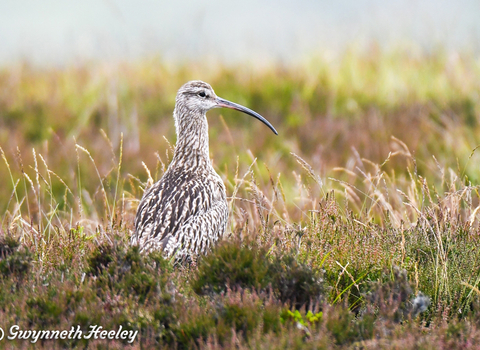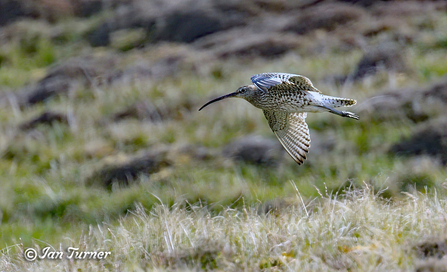
Curlew (c) Gwynneth Heeley
Curlew
The curlew Numenius arquata known as the common curlew or Eurasian curlew is one of seven species of curlew found world wide.
It is one of the most widely distributed species, found across central Europe and Asia. There are three subspecies of the Eurasian Curlew each with a different distributions, ours is Numenius arquata arquata found in northwestern and central Europe.
The curlew is our largest wading bird with a wing span of almost 1 m, a long down curved bill (about 15cm long), long legs, mottled brown back and wings and a very distinctive and beautifully haunting call. The only other bird species it may be confused with in the UK are the smaller less common whimbrel, which also has a shorter bill, and godwits, which have a straight bill.
Curlews normally live to around 20 years, with one recorded as reaching 31 years! They don’t breed until they are at least 2 years old but often return to the same breeding site with the same partner year on year. So if you see a pair returning in spring to a field near you it may know the area better than you. The male and female look very similar but if you see them together the larger one with a longer bill is most likely the female. They nest in wet meadows, sheep pasture and upland areas where the ground is wet enough and insect life rich enough to enable them to feed their young. Ideally there should be less then 30% rush cover and a mixture of short and long vegetation providing cover for young to hide and open areas to forage. This is best created by a mixture of sheep and cattle grazing. They prefer not to nest too close to trees as trees provide a perch for predatory birds and cover for ground predators such as fox.

Curlew (c) Ian Turner
The UK holds about a quarter of the world population of curlew and due to recent declines it has been listed in the UK as a Red list species, that is, as one of our most endangered birds. Between 1996 and 2016 curlew populations are estimated to have declined by more than 50% in England and Scotland, more than 80% in Wales, and more than 90% in Ireland with declines most marked in lowland areas. The detailed reasons for this decline are still being investigated but it is thought to be due to a combination of factors. Changes in land use and farming practices have resulted in many places in larger machinery and more frequent cutting of silage and hay sometimes resulting in accidental death of chicks, important wetland habitat has declined and may be further affected by climate change and the increased use of chemicals in agriculture will have effects on the soil fauna and those that feed on it.
As curlews are relatively long lived birds the decline has taken time to become evident. Research into this decline and projects aimed at halting it are underway. In addition to this the WWT (World Wetlands Trust) are undergoing a Headstarting project together with Natural England and the Ministry of Defence. They are hand rearing Curlew chicks from eggs collected from airfields which would have been destroyed under license to protect flight safety. Birds are then released onto lowland farms where the farmers are keen to support these birds by creating ideal habitat as part of their farming practices. These released birds should help to boost local populations with the added benefit of being watched over by the local farming community.
